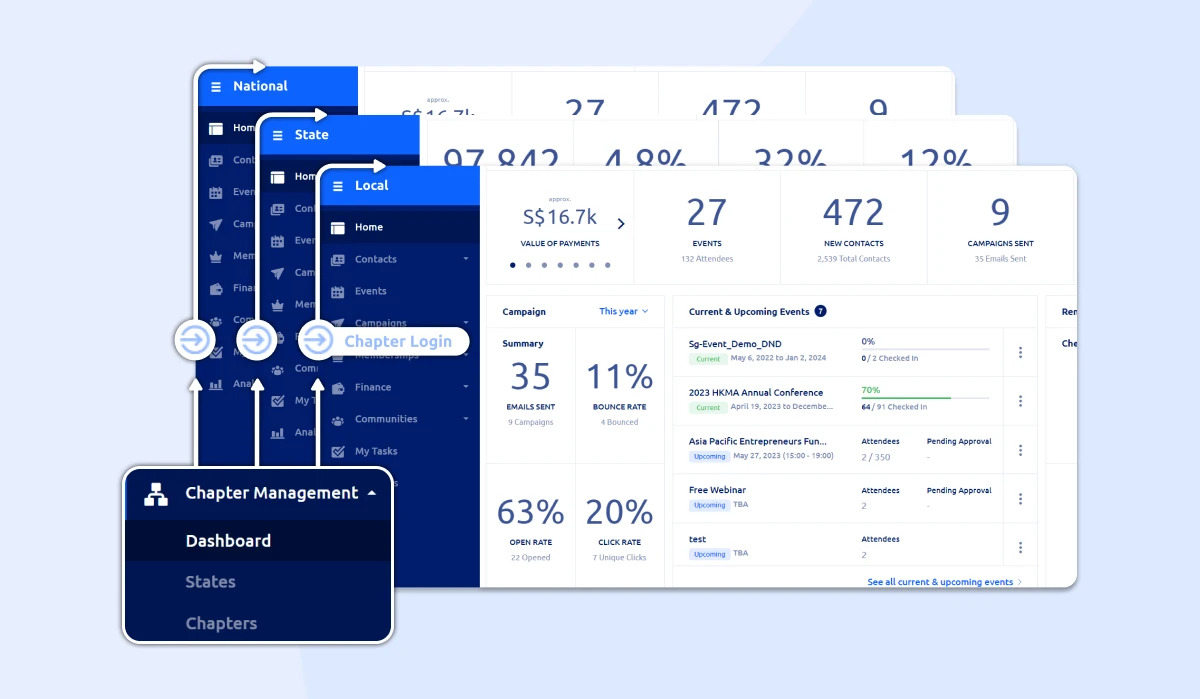
Benchmarking allows you to compare your association's chapters’ performance with industry standards or similar organizations. But how can you use this powerful tool to drive specific behaviors and boost engagement effectively?
In this blog post, we will delve into five actionable ways you can leverage targeted benchmarking to drive your association’s chapter behavior. We’ll also explore practical strategies to encourage active participation, foster a stronger sense of community, and ultimately, elevate your association to new heights.
But first…
Targeted Benchmarking: What Is It and How Does It Influence Chapter Behavior?
Targeted benchmarking is a systematic process through which an association’s chapter compares its performance metrics with industry standards or best practices.
This approach is ‘targeted’ because it focuses on specific key performance indicators (KPIs) that are critical to the chapter's success, rather than a broad spectrum of metrics.
Benchmarking is vital for understanding how a chapter stands in relation to similar organizations. It allows chapters to identify gaps in their performance and seek ways to improve.
By aligning operations with proven standards and best practices, chapters can elevate their performance, increase member satisfaction, and have a more substantial impact on their communities.
How to Choose the Right Benchmarks for Chapters?
Select benchmarks that align with your chapter’s goals and mission. These should be relevant, and measurable, and should correspond to the areas your chapter considers vital for success. Consult with stakeholders, review industry standards, and consider benchmarks that competitors or peers are using.
Key Performance Indicators for Chapter Success

Membership Growth
This metric measures the number of new members who join the chapter each year. Tracking membership growth helps to understand the chapter's appeal and indicates the effectiveness of its recruitment strategies.
Retention Rate
This metric measures the percentage of members who renew their memberships each year. A high retention rate is usually a sign of member satisfaction, while a low rate may flag issues that need attention.
Activity Participation
This metric measures the percentage of members who participate in chapter activities. High participation rates often correlate with engaged and satisfied members.
Volunteer Satisfaction
This metric measures the level of satisfaction that members have with the chapter's volunteer opportunities. Satisfaction surveys can help pinpoint what volunteers find rewarding and where improvements are needed.
Community Impact
This metric measures the impact that the chapter has on its community. This can be assessed through surveys, feedback from community leaders, or by tracking specific initiatives and their outcomes.
Benefits of Chapter Benchmarking in Associations
Benchmarking chapters within associations offers several significant advantages. Here is a breakdown of the key benefits:
Identification of Underperforming Areas
Benchmarking helps associations pinpoint the areas where their chapters may not be meeting performance expectations. This information serves as a foundational tool for developing targeted improvement plans.
Recognition of Exceptional Performance
Through benchmarking, associations can identify bright spots, or chapters that are performing exceptionally well. Studying these high-performing chapters allows associations to learn from their best practices and consider implementing similar strategies in other chapters.
Fostering a Culture of Continuous Improvement
Benchmarking encourages associations to build a culture that values continuous improvement. Regular comparisons between chapters facilitate the identification of areas that could be further enhanced, promoting an ethos of constant growth and development.
Informing Strategic Planning
The data collected through benchmarking can inform the association's broader strategic planning process. It helps in setting realistic goals, allocating resources effectively, and designing actionable plans that align with the association’s overall mission and vision.
5 Ways to Boost Chapter Engagement with Targeted Benchmarking
# 1: Understand the Diversity of Chapters
Each chapter in an association likely has a unique set of circumstances, with variations in size, location, demographics, and resources. Recognizing these differences is essential when comparing performance metrics.
Strategy: Customize benchmarks according to chapter characteristics, avoiding a one-size-fits-all approach.
- Tailor performance indicators that are based on a chapter's size, member demographics, and location. For instance, rural chapters might have different engagement metrics than urban ones due to variations in member accessibility.
- Consider the unique strengths and challenges of each chapter. This can include financial resources, a volunteer base, and existing engagement levels.
- Utilize a flexible benchmarking platform that allows chapters to compare themselves to similar chapters, rather than all chapters in the aggregate. This will help in forming more realistic and actionable insights.
#2: Avoid a Culture of Competition
Benchmarking can inadvertently create a competitive atmosphere among chapters, which might work against the association's overarching goals of collaboration and shared success.
Strategy: Use benchmarking as a tool for learning and collaboration, not competition. Promote a culture of sharing and mutual support among chapters.
- Facilitate Knowledge Sharing: Organize regular chapter meetings or forums where chapters can share their successes and challenges openly, and learn from each other’s experiences.
- Celebrate Diverse Strengths: Develop an awards or recognition program that honors different kinds of successes, such as a most improved chapter or exemplary community service.
- Encourage Mentorship and Partnership: Establish a mentorship program where more experienced chapters can provide guidance and support to newer or struggling chapters.
#3: Ensure Data Quality and Consistency

For benchmarking to be effective, the data collected must be accurate, consistent, and comparable across chapters. Poor quality data can lead to misleading results, which could, in turn, lead to incorrect decisions and strategies. Ensuring that data is of high quality and consistent across all chapters is paramount for successful benchmarking.
Strategy: Establish Clear Guidelines and Standards for Data Collection
- Develop a Data Collection Protocol: Create a detailed guide outlining the necessary metrics, methods for collection, and responsible parties. Standardize metrics and definitions across all chapters to ensure uniformity and clarity.
- Implement Training and Quality Checks: Train chapter representatives on the data collection protocol. Establish regular quality checks, both automated and manual, to identify and correct inconsistencies and errors at various stages of the data collection process.
- Regularly Audit, Validate and Provide Feedback: Schedule periodic audits of the data collected by different chapters. Following audits, offer feedback to chapters about their data quality and consistency, and use this as an opportunity for continuous improvement.
#4: Empower Chapter Leaders with Data
Chapter leaders should not only have access to benchmarking data but also be trained to interpret and use this information effectively. By empowering chapter leaders with actionable insights drawn from data, they are better equipped to make informed decisions, set realistic goals, and implement successful strategies that boost engagement and productivity.
Strategy: Provide training sessions for chapter leaders on data analysis, interpretation, and application
- Develop a comprehensive training program tailored to individual chapter needs.
- Establish ongoing support through mentorship and accessible resources.
- Encourage actionable insights and SMART goal-setting based on data analysis.
#5: Provide The Right Resources and Support
Empower chapters with the resources and support they need to thrive. This includes tailored funding opportunities, dedicated staff, and tech support to meet the unique needs of each chapter.
Strategy: Use a comprehensive tool to streamline your chapters' collaboration
Leverage tools designed to enhance chapter performance significantly. For instance, Glue Up is a comprehensive chapter management software that streamlines data collection, analysis, and reporting, thereby enabling chapters to engage in effective and efficient benchmarking.
By employing such a tool, chapters are empowered with the necessary data and insights to continually assess their progress, set realistic goals, and implement strategies that drive measurable improvement in their engagement and overall performance.
How to do the Targeted Benchmarking using Glue Up’s Chapter Management Software?

With an increasing emphasis on the digital transformation of professional associations and chapters, there's a growing need for efficient tools that offer streamlined coordination and benchmarking capabilities.
Now you can coordinate all your chapters’ activities and improve their performance using Glue Up's chapter management software.
By centralizing various chapter activities and data sources, Glue Up enables chapters to not only manage daily operations with ease but also effortlessly benchmark their performance against pre-defined standards or metrics.
Here’s how you can optimize your chapters’ benchmarking using the all-in-one engagement management software:
Establish clear KPIs
Initiate the benchmarking process by setting clear KPIs, such as membership growth or event participation. Understand what you want to achieve and articulate it clearly. This could be increasing member engagement or improving event attendance.
Establish both short-term and long-term goals to give your benchmarking direction and purpose.
Centralized Data Collection
Integrate all your data sources within Glue Up's CRM, ensuring consistent and comprehensive information. Use this centralized system to record member activities, track event registrations, and store member feedback. This way, all your essential data is in one place, ready for analysis.
Leverage the automation feature to reduce manual data entry and minimize errors.
Conduct an In-depth Analysis

Use Glue Up's analytics dashboard to identify trends and draw actionable insights from the collected data. Compare your chapter’s performance against your set benchmarks and understand where improvements are needed. This analysis can guide your chapter in decision-making and setting new strategies.
Reflect on these insights periodically to track progress and adjust as necessary.
Share and Strategize
Present your findings to stakeholders and adapt strategies based on the derived benchmarking results. Creating clear and detailed reports will help stakeholders understand the current situation. Use these insights to collaborate on new strategies for improvement.
Ensure that these strategies are communicated to the entire team and are acted upon in a timely manner.
Implement Changes
Based on your benchmarking analysis, develop and execute a plan to implement necessary changes. This could mean revising marketing strategies, enhancing member services, or adjusting event formats.
Monitor the results of these changes closely and be prepared to adjust your strategies as you learn more from subsequent data.
Monitor and Adjust
Make it a habit to regularly review your reports and dashboards in Glue Up’s software. Use this ongoing data to continually refine your strategies and approach. This allows for adaptive and responsive management, keeping your chapter agile and competitive.
Regular reviews will help you stay aligned with your goals and make data-driven decisions.
In essence, targeted benchmarking is not just about numbers. It's about fostering a culture of excellence, growth, and collaboration. By implementing these strategies, you can not only improve individual chapter performance but elevate the entire organization to new heights.
Interested in guiding your chapters toward success? Explore our ebook, “The Ultimate Guide to Membership Management for Associations” for insightful strategies. You can also get a demo of Glue Up’s all-in-one engagement management software to discover how you can catalyze remarkable growth and engagement across your multi-chapter organization.
FAQs
What is targeted benchmarking in the context of an association's chapter?
Targeted benchmarking involves comparing specific performance metrics of an association's chapter with similar entities or standards. This process helps identify areas for improvement and fosters a culture of excellence within the chapter.
How can targeted benchmarking boost engagement in my chapter?
By using targeted benchmarking, you can identify best practices and set achievable goals for your chapter. This encourages members to actively participate in initiatives aimed at reaching or surpassing those benchmarks, thereby boosting overall engagement.
What kind of metrics should I consider for targeted benchmarking?
Common metrics for targeted benchmarking include member engagement levels, event attendance rates, fundraising success, member retention rates, and volunteer participation. These metrics help you get a comprehensive view of your chapter's performance.
Is targeted benchmarking time-consuming or resource-intensive?
While targeted benchmarking requires an investment of time and potentially some resources, the process can be streamlined by using modern tools and software. The insights gained often lead to more efficient operations and higher member engagement, making the effort worthwhile.
How often should our Drive Association’s chapter engage in targeted benchmarking?
It is generally advisable to conduct targeted benchmarking at regular intervals, such as annually or semi-annually. This allows your chapter to track progress over time, adjust strategies as needed, and consistently focus on improvement and member engagement.



